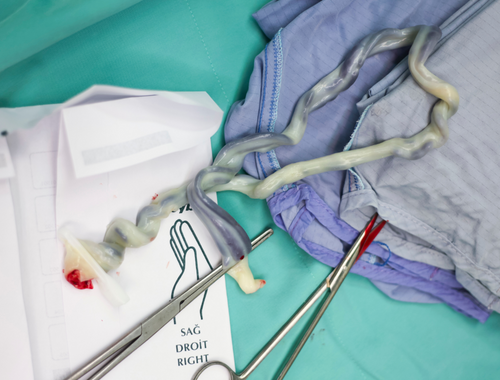Difference Between Umbilical Granuloma and Polyp
An umbilical granuloma is a remnant of tissue that can form after the umbilical cord detaches. An umbilical polyp is a birth defect in which parts of embryonic tissue remain at the naval.

What is Umbilical granuloma?
Definition:
An umbilical granuloma is a piece of tissue that can develop on a baby’s naval after the umbilical cord is detached.
Appearance and structure:
The umbilical granuloma looks like a red and moist bump or lump, and it is found at the belly button of the baby.
Formation:
An umbilical granuloma is scar tissue that is created after the umbilical cord has fallen off. It is rare, but such a structure can also form in adults. Most often, though, this granuloma can be found in newborn infants.
Symptoms and complications:
The granuloma appears red and is swollen, often resembling a moist button. There is also sometimes a clear discharge from the granuloma. Although the granuloma often goes away on its own, the concern is the potential for infection. Unlike a polyp in the naval, a granuloma will not bleed.
Treatment:
Some common treatment methods are using silver nitrate or salts and applying these to the bump. The granuloma can also be removed by cryotherapy, ligation, or surgery.

What is Umbilical polyp?
Definition:
An umbilical polyp is the remains of an embryological structure called the omphalomesenteric duct (OMD) that is found as a small bump in the naval.
Appearance and structure:
The appearance of an umbilical polyp is that of a round mass that is found at the belly button. Gastrointestinal tissue, specifically, mucosal cells may be found in the polyp. The polyp also has a glandular appearance. The polyp also may be connected to underlying organs in the abdomen.
Formation:
It is rare, but sometimes a polyp develops at the umbilicus in babies. This is a congenital defect, meaning it occurs at birth.
Symptoms and complications:
The symptom of an umbilical polyp is the presence of a red mass that also bleeds. This is one way that the polyp can be distinguished from an umbilical granuloma. A granuloma won’t bleed. A polyp is also often deeper and connected to other organs in the body. Serious complications can be associated with an umbilical polyp. Such complications include infection, intussusception, hernia, volvulus, and peritonitis.
Treatment:
An umbilical polyp will not go away on its own. Surgical removal, preferably a small laparotomy procedure, is advisable.
Difference between Umbilical granuloma and Polyp?
Definition
An umbilical granuloma is a small bump at the navel, found in newborns. An umbilical polyp is a mass at the umbilicus that often bleeds.
Cause
An umbilical granuloma forms because the cord falls off. A polyp is due to a birth defect.
Structure
In the case of an umbilical granuloma, the structure is a red, moist bump. In the case of a polyp, the structure is a red, firm lump that bleeds with ease.
Histology
An umbilical granuloma consists of fibroblasts, tiny vessels, inflammatory white blood cells, and endothelial cells. A polyp is a gland-like structure that is lined by the mucosa of the intestine and, in some cases, even urinary tract tissue.
Complications
The main complication that can happen with an umbilical granuloma is infection. There are several possible complications that can occur with a polyp, namely, hernia, infection, intussusception, volvulus, and peritonitis.
Treatment
Although an umbilical granuloma may heal on its own, there are possible treatment methods that can be used. These include using salts, silver nitrate, ligation, cryotherapy, and surgery. An umbilical polyp always needs treatment in the form of surgery (laparotomy is the best method).
Prevalence
An umbilical granuloma is common in newborns. A polyp at the umbilicus is rare in babies.
Table comparing Umbilical granuloma and Polyp

Summary of Umbilical granuloma Vs. Polyp
- An umbilical granuloma and polyp are both excess tissue that occurs in the belly button of babies.
- An umbilical granuloma is normal and often heals on its own.
- A polyp in the belly button always needs to be treated, usually with surgery.
FAQ
What does an umbilical granuloma look like?
A granuloma looks like a red swelling in the belly button. The lump also often appears moist.
How are umbilical polyps removed?
The convention is to do a laparoscopic surgery to excise the polyp.
What is an umbilical granuloma?
An umbilical granuloma is scar tissue that forms a small swollen area where the umbilical cord detaches.
Can I bathe a baby with umbilical granuloma?
No, you should not place the baby in a bath until the granuloma has healed completely. The best strategy is to do a simple sponge bath of the baby but make sure to keep the granuloma dry.
How do you shrink a granuloma?
Silver nitrate can help to shrink the granuloma.
How long does it take for an umbilical granuloma to go away?
An umbilical granuloma often goes away in about 7 days.
How long does a granuloma take to heal?
Normally, an umbilical granuloma heals within a week after birth.
.
- Difference Between Rumination and Regurgitation - June 13, 2024
- Difference Between Pyelectasis and Hydronephrosis - June 4, 2024
- Difference Between Cellulitis and Erysipelas - June 1, 2024
Search DifferenceBetween.net :
Leave a Response
References :
[0]Karagüzel, G., and H. Aldemir. "Umbilical granuloma: modern understanding of etiopathogenesis, diagnosis, and management." J Pediatr Neonatal Care 4.3 (2016): 00136.
[1]Kim, Dong Hyeon, et al. "Differential diagnosis of umbilical polyps and granulomas in children: sonographic and pathologic correlations." Ultrasonography 40.2 (2021): 248.
[2]Pacilli, M., et al. "Umbilical polyp in infants and children." European journal of pediatric surgery 17.06 (2007): 397-399.
